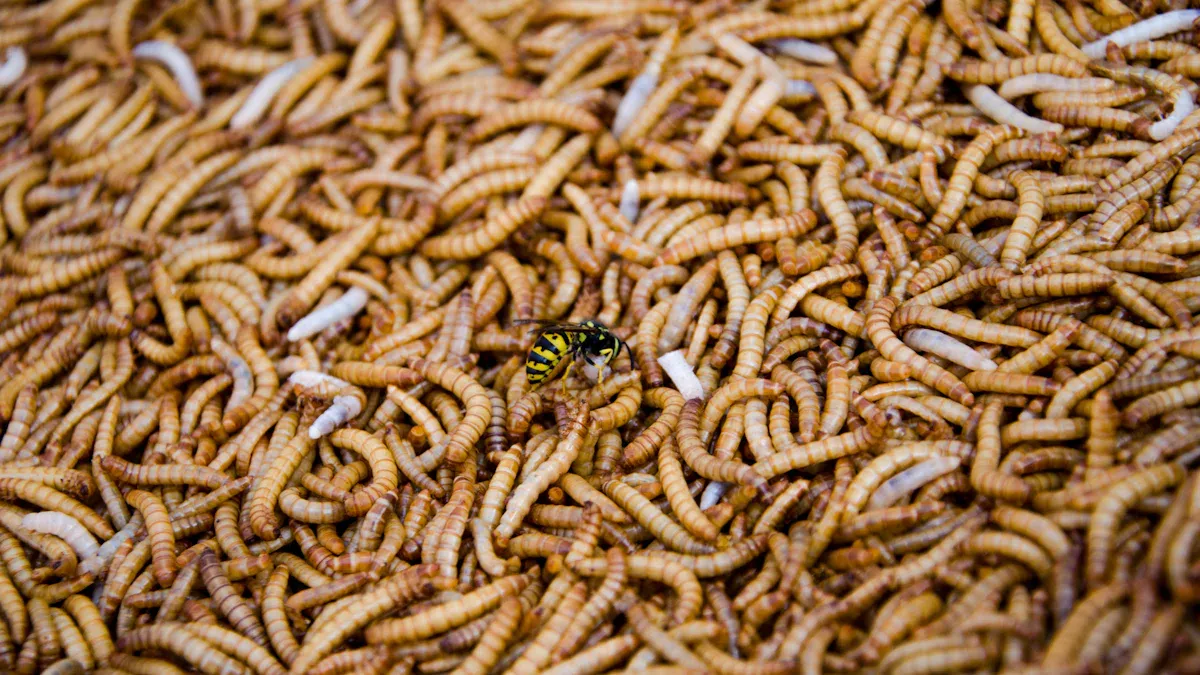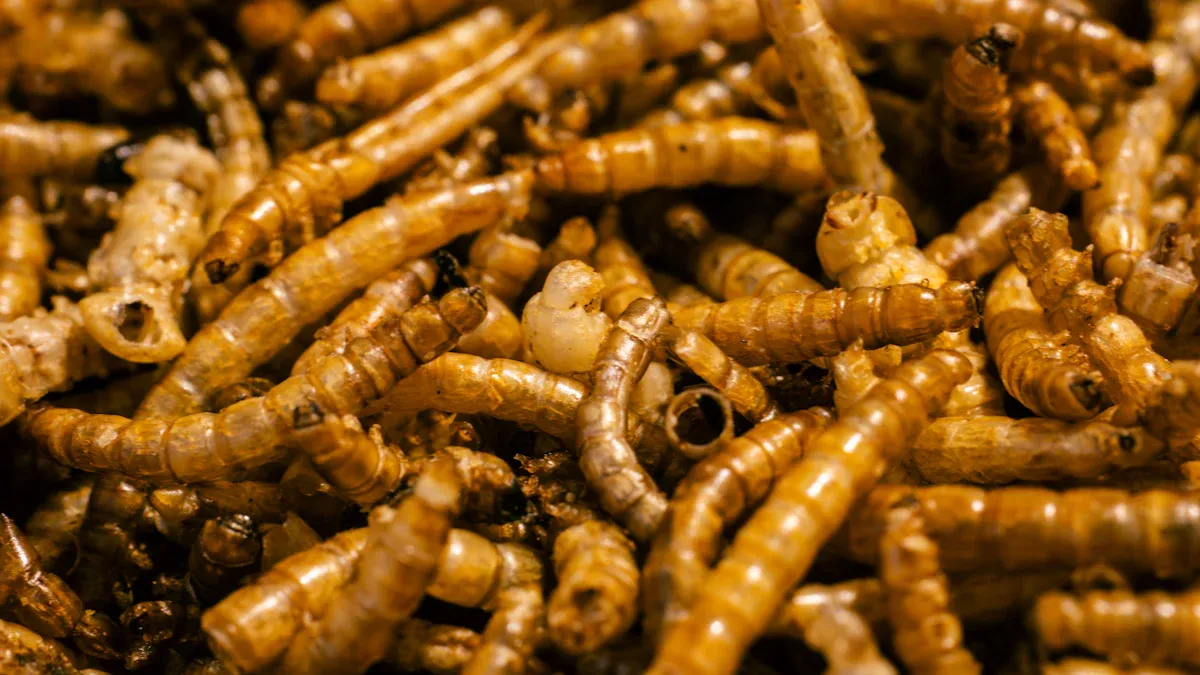
Dried Mealworms for Parrots make a tasty and safe treat. They offer protein, healthy fats, and fiber. These nutrients help support strong muscles, shiny feathers, and good health. Parrots enjoy the crunchy texture and rich flavor, making every snack time special when served in moderation.
Key Takeaways
- Dried mealworms provide parrots with high protein and healthy fats that support strong muscles, shiny feathers, and good health.
- Serving dried mealworms in different ways, like mixing with other foods or hiding in toys, encourages natural foraging and keeps parrots active and happy.
- Feed dried mealworms in moderation and store them in a cool, dry place using airtight containers to keep them fresh and maintain a balanced diet.
Why Parrots Love Dried Mealworms for Parrots
Instinctual Attraction to Protein
Parrots need protein to stay healthy. Their bodies use protein to build muscles and grow strong feathers. In the wild, parrots often search for insects and other protein-rich foods. Dried Mealworms for Parrots provide a similar source of protein. Many parrots show excitement when they see these treats. Their natural instincts guide them to foods that help them grow and stay active.
Protein helps parrots repair their bodies after play or flight. It also supports their immune system. When parrots eat Dried Mealworms for Parrots, they get a boost of energy and nutrition.
Natural Foraging and Taste Appeal
Parrots enjoy searching for food. Foraging keeps their minds sharp and their bodies busy. Dried mealworms encourage this natural behavior. Owners can hide mealworms in toys or scatter them in the cage. Parrots will spend time looking for each tasty bite. This activity makes snack time fun and rewarding.
The taste and texture of dried mealworms appeal to many birds. Parrots like the crunchy feel and rich flavor. These treats add variety to their diet. Some owners notice their parrots become more active and playful after eating dried mealworms.
- Dried mealworms can be served alone or mixed with other foods.
- They are easy to store and use as a quick treat.
Nutritional Benefits and Serving Tips for Dried Mealworms for Parrots

Protein, Fat, and Fiber Content
Dried mealworms offer a powerful nutritional boost for parrots. Studies show that dried mealworms contain about 48% to 52% protein, making them an excellent source for muscle and feather growth. The fat content ranges from 25% to 38%, providing energy and supporting healthy skin. Fiber levels are lower, but they still help with digestion. Researchers have compared dried mealworms to other animal protein sources and found that their amino acid profile supports overall bird health. The stable nutrient profile of dried mealworms means that parrots receive consistent nutrition with every serving.
| Nutrient | Percentage Range |
|---|---|
| Protein | 48% – 52% |
| Fat | 25% – 38% |
| Fiber | Low |
| Carbohydrate | 8% – 18% |
These values show why Dried Mealworms for Parrots are a smart choice for owners who want to support their birds’ health.
How to Serve Dried Mealworms
Serving methods can affect the nutrition parrots get from dried mealworms. Laboratory research shows that different drying methods, such as convective drying and freeze-drying, change the levels of protein and amino acids. Convective drying at higher temperatures helps keep more essential amino acids and protein quality. Freeze-drying can lower protein content but may keep some heat-sensitive nutrients. Owners can serve dried mealworms in several ways:
- Mix them into seed blends or pellets.
- Offer them as a treat in a separate dish.
- Hide them in foraging toys to encourage natural searching behavior.
Tip: Try different serving methods to see which your parrot enjoys most. This also helps keep mealtime interesting and fun.
Moderation, Storage, and Balanced Diet
Parrots need a balanced diet, so moderation is important when feeding dried mealworms. Scientific studies show that dried mealworms are high in fat and low in calcium. Feeding too many can cause nutritional imbalances, especially if they replace other foods. Overfeeding may also change a bird’s gut health. Owners should offer dried mealworms as a treat, not as the main food.
Proper storage keeps dried mealworms fresh and nutritious. Research shows that storage conditions affect protein and fat levels. Keeping dried mealworms in a cool, dry place helps preserve their nutrients. Airtight containers work best to prevent moisture and spoilage.
- Store dried mealworms in a sealed container.
- Keep them away from direct sunlight and heat.
- Check for freshness before serving.
Dried Mealworms for Parrots fit well into a varied diet that includes fruits, vegetables, seeds, and nuts. Owners should always choose high-quality products from trusted sources to ensure safety and nutrition.
Dried Mealworms for Parrots give birds a protein-rich treat that supports muscle and feather health. Owners can mix them with other foods for variety. Proper storage keeps them fresh. Choosing high-quality products helps parrots stay healthy and satisfied. Serve these treats in moderation for the best results.
FAQ
Can all parrot species eat dried mealworms?
Most parrot species can enjoy dried mealworms as a treat. Owners should always introduce new foods slowly and watch for any signs of allergies or digestive upset.
How often should parrots eat dried mealworms?
Parrots should eat dried mealworms two to three times per week. Owners should use small amounts to keep the diet balanced and healthy.
What is the best way to store dried mealworms?
Store dried mealworms in an airtight container. Keep them in a cool, dry place. This method helps maintain freshness and prevents spoilage.


